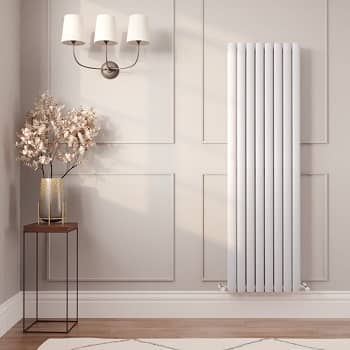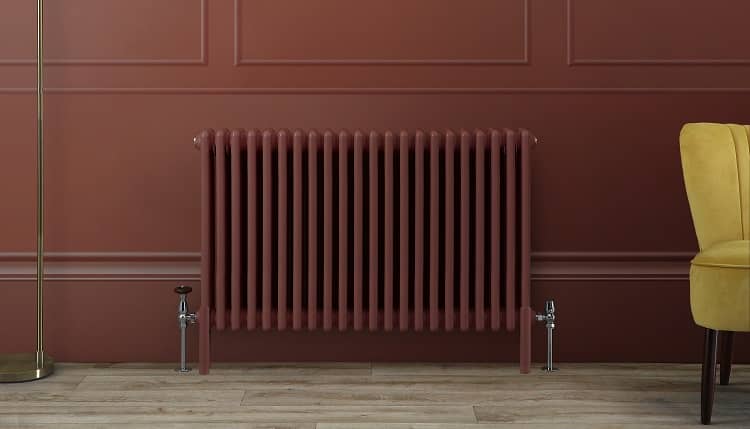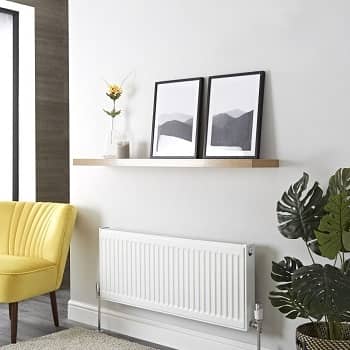Buying a radiator online can be daunting.
There are a lot of things to consider before purchasing a new radiator for your home.
The size, shape and heat output are all important factors in selecting the best radiator to purchase.
And, on top of that, there’s the style, material and finish to think about too.
So, buying a new radiator isn’t something to take lightly.
To help, we’ve created this updated guide on how to buy a radiator to help you make the BestHeating choice for your home.
Contents
ToggleHow to buy your new radiator

In this guide, we’ll provide you with all the information you need to make an informed decision when buying a radiator online.
Follow the steps below to help you on your way to purchasing a new radiator.
Step 1 – Determine the size of radiator you need
The first step on your journey to a new radiator, is to understand the size of radiator you need.
Your radiator’s size depends on the size and type of room you will be heating.
A larger room will obviously need a larger radiator (or perhaps more than one), while a smaller room is going to require a smaller radiator.
The process of determining your radiator size involves measuring the height, width and length of your chosen room.
Those figures, alongside other factors like the type of walls you have, and what is above and below the room, can all impact the size of the radiator you need.
When you have all the information, make use of our online BTU Calculator to help you find the required heat output for that space.
For extra help on understanding the required BTUs for your new radiator or towel rail –
check out our ultimate guide to calculating heat output for your home
Step 2 – Choose the type of radiator
There are several types of radiator to choose from to heat the different rooms of your home.
The type of radiator you choose will depend on your heating needs and your personal preference.
To help you to buy the perfect radiator, check out the different radiator types below.
Panel radiators
Panel radiators are probably the most common type of domestic radiator.
They are available in single, double and double-panel-plus varieties – each of which offer a little more in terms of heat output than the next.
The numbers on the graphics above indicate the number of panels and the number of convector fins that the radiators feature.
Though they may look very similar, the radiators below are very different.
The first – a Type 11 convector – offers around 3,000 BTUs, while the third – a Type 22 – offers almost twice the heat output, at 5,500.
Panel radiators are relatively inexpensive, reliable and consistent in their heat output.
If you’re looking for a functional, affordable radiator, you won’t go far wrong with one of these.
For more insight into the different types of panel radiators –
pay a visit to our convector radiator guide.
Column radiators
Column radiators are usually more traditional in their design.
They consist of a series of vertical tubes instead of a panel.
You can find both traditional and contemporary column radiators at BestHeating.
For more modern column radiators, you should browse our designer radiators category.
These modern radiators are great for contemporary living spaces, like loft apartments.
Conversely, period-style traditional column radiators are ideal for restoration projects and more vintage look properties.
Learn all about column radiator efficiency in our column radiator guide
Towel radiators
Towel radiators are typically used in bathrooms and contain rails to hang towels on.
Not entirely the same as a heated towel rail – which is specifically designed to hold towels – towel radiators look just like other radiators in your home, but come equipped with a rail for your towel to sit on.
Step 3 – Select the perfect radiator material
“They’re made of metal!” I hear you say.
Well, yes, radiators are usually made of metal.
But, there are different types of metals that a radiator can be made from – each with varying advantages and disadvantages.
Here are some common radiator materials and their key benefits.
Steel radiators
Steel is the most common radiator material in the UK and definitely the most affordable.
At BestHeating, unless otherwise stated on the product pages, all our standard radiator designs are made from mild steel.
Steel is durable, easy to maintain, and great at emitting heat, making it one of the best all round materials for radiators and towel rails.
Aluminium radiators
Aluminium radiators are lightweight and offer excellent heat conductivity.
They heat up quickly and are very energy efficient, but they are also more expensive than steel radiator designs.
You can learn more about the heating properties of aluminium radiators in our aluminium radiator guide.
Cast iron radiators
Probably the most durable and enduring radiator material, cast iron radiator will last for many years.
The heaviest of the radiator materials you can choose from, cast iron takes a while to reach its top temperature, but will retain heat much longer than steel and aluminium.
Discover how cast iron radiator designs can make an impression in your home, by visiting our guide to modern cast iron radiators.
Step 4 – Consider the style of your radiator
Radiators come in many different styles, from modern to traditional.
Choosing a radiator that fits the style of your home can help to enhance its overall appearance.
Modern radiators are often sleek and minimalist in design, while traditional radiators can be more ornate and decorative.
Modern

Traditional

Which style radiator you choose to buy is down to your own tastes and needs.
If you have a modern home, there is nothing stopping you from opting for a more traditional design should you want it.
While adding a modern radiator to a period property can also help to enhance the space in ways you may not have previously thought.
Step 5 – Choose your radiator’s colour
You may already have a colour in mind for your new radiator, and that’s great!
But, have you considered changing things up a bit and making your heating “cooler”?

At BestHeating, we have a broad collection of coloured designer radiators that can help you to add a touch of glamour to any space.
From white to black and everything in between, you are no longer tied to basic radiator colours.
You can mix and match, contrast with wall colours and get really creative in whatever way you like.
But, if you do want a white radiator for a classic style, we have plenty of white radiators to choose from too!
Not sure if a coloured radiator is for you?
Take our colour personality test to find out which radiator colour suits you best!
Step 6 – Remember energy-efficient features
When choosing a radiator, it is important to look for energy-efficient features, such as thermostatic radiator valves and heat output controls.
These features can help to reduce your energy bills and ensure that your radiator is operating at peak efficiency.
For more info on how to optimise your home’s heating, check out our guide on radiator efficiency and performance.
Step 7 – Be sure to buy from a reputable supplier
We are not the only online radiator supplier.
However, you will benefit from expert advice, industry-leading product guarantees and award-winning customer service.
So, although you may have heard about other radiator outlets, why go anywhere else for your radiator fix, when we have it all at BestHeating?
A quick recap about how to buy a radiator
So let’s have a quick recap on how to buy a radiator –
- Calculate your BTU output needs
- Choose the type of radiator you want (panel, column, towel, etc)
- Select the material you want your radiator to be made of (steel, aluminium, cast iron)
- Decide on your radiator style (modern or traditional?)
- Mix and match your radiator colour
- Check for energy saving extras
- Buy it from BestHeating!
Now you know how to buy a radiator, all that’s left to do is go and choose the one you want!
We call it – “heating made cooler” – and so should you!
Frequently Asked Questions
BestHeating offer an excellent selection of cheap designer radiators, some of which retail for as little as £80.
Many of our radiators are accompanied by a 20-year guarantee so buyers can enjoy peace of mind as it pertains to radiator performance, and a wide range of stylish options are available.
For further information surrounding cheap designer radiators, take a look at our dedicated blog on the subject – Cheap Designer Radiators: Too Good To Be True?
The key thing to consider when choosing bathroom radiators is the size of the bathroom area they’ll be fitted in.
If you select a bathroom radiator that is too big, not only will it look out of place, but it will also cause your energy bills to increase unnceccesarily.
Contrastingly, opting for a bathroom radiator that is too small could leave you devoid of an adequate heat output in the bathroom, and in need of an additional heating source like a designer radiator.
For more advice on choosing a cool new bathroom radiator, check out our Ultimate Guide to Heated Towel Rails
There are four main materials typically used in the construction of radiators.
You are likely to encounter radiators made from stainless steel, mild steel, cast iron or aluminium.
Consult the BestHeating Radiator Buying Guide for a full insight into the benefits associated with each different type, and decide which radiator material is best suited to your requirements.
No. There are a wide variety of electric radiators available in an immense choice of sizes, shapes and styles.
Our full Advice Centre blog, Should You Buy An Electric Radiator, offers a full insight into this particular type of heating device.
Aluminium radiators provide the highest potential BTU output possible.
That doesn’t mean that every aluminium radiator has a higher heat output than every steel radiator, for example. But aluminium radiators have the greatest heat output potential of any type.
In addition to this, they are also the fastest type of radiator to heat up and spread their warmth, and offer excellent responsiveness as well.
Our blog entitled Why Buy Aluminium Radiators explains in more detail. And for further insight into all types of different radiators, take a look at the BestHeating Radiator Buying Guide.
Aluminium is widely considered to be the best material for a radiator.
As a material, aluminium offers excellent conduction properties, enabling radiators to heat up quickly and transport heat around the space rapidly as well.
Aluminium radiators also provide the highest possible BTU output and have superb responsiveness, so tend to be the most expensive available type as a result.
Our Why Buy Aluminium Radiators blog offers a more in-depth look at aluminium radiators, and there’s analysis of all different types of radiators in the BestHeating Radiator Buying Guide.
You can change your home radiators at any time of the year, but there are many reasons to suggest the summertime is as good a time as any.
Typically, better weather will ensure you can go without the use of radiators for a few days or weeks, and plumbers will also generally be less busy throughout the summer months, and able to assist new installations more readily.
Find out more in our Advice Centre blog, Summertime – the best time to change your radiators. And, for inspiration on the best new radiators to select for an upgrade, consult our comprehensive radiator buying guide.
There are a multitude of benefits to both electric and plumbed radiators, with both types offering unique properties and advantages.
Electric radiators, filled with glycol, can operate independently of a central heating system, whilst plumbed rads rely on the central heating to work.
Consult the BestHeating Radiator Buying Guide to help you decide on the perfect style of radiator to suit your space.
Additional radiator buying resources
For extra help in buying your new radiator, click on the links below.
The BestHeating radiator buying guide – our super in-depth guide on every radiator type and how to buy them at BestHeating (think of it as an extension to this guide you’re reading now!).
The top 5 vertical central heating radiators – an article exploring our favourite five vertical central heating radiators from the BestHeating collection.
Why purchase a bench radiator – join us as we explore this practical and stylish, alternative heating solution.
Vertical or horizontal radiators – Which is right for you? – our take on whether you should choose a vertical or a horizontal radiator for your chosen room.

John trained in journalism before finding his way to the BestHeating Advice Centre team. He uses his journalism skills to meticulously research heating topics and bring you the latest news and views on all things home heating related. He’ll also beat you at any sport that involves a cue!













